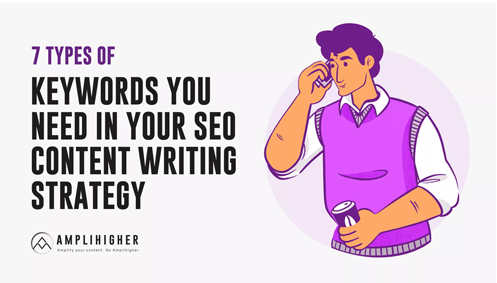Updated Aug 13, 2024
Part of a bulletproof content strategy is conducting regular content audits. Although the content auditing process can be tedious and nuanced, ensuring that your current content is aligned with your brand objectives AND getting you results make it worth the effort.
The term “audit” might automatically send you into a downward spiral (and really, who’d blame you?) but conducting a content audit can be done in 6 straightforward steps.
Let’s look at how you can audit your website content and use your findings to rocket-power your SEO content writing.
- Determine Your Goals

The first step in a content audit is to clearly define your goals. In other words, what are you auditing for? No one audits because it’s fun.
List out your main goal and create a checklist of what to review.
For example:
If Your Goal is Search Engine Optimization
If the goal of your audit is to ensure that all of your website content is optimized for search, you’ll want to focus on:
- Assigned keywords. Does each page have a keyword focus?
- Quality. Is your content informative, useful, helpful, and created with SEO content writing techniques in mind?
- Relevance. Does your content match your current brand objectives? Is the content up-to-date with the most current industry information?
- Content mapping. Are you using contextual links so that search engines and users can easily find other related content on your site?
- User intent. Does each piece of content address a specific question or problem? Have you addressed all content gaps in the market?
Search engines like content that’s easily scannable by both search engines and users alike. The better your content, the more likely it is that it will rank on search engines.
If Your Goal is Brand Cohesiveness
If you’re auditing the written content on your website to evaluate where or not your brand is cohesive across all pages, you’ll focus on:
- Tone: Does the tone of your content match your brand personality and is it consistent across all pages? For example, are some of your pages more playful and witty while other pages are more straightforward and serious?
- Voice: Is your brand voice consistent throughout your entire website? Is the phraseology on each page consistent? For example, are you using long, descriptive sentences on some pages and short, blunt, concise sentences on the others?
In other words, does each page sound like it was written by the same person and does every page reflect how you want your brand portrayed?
And, even if the primary goal of your content audit is the written content, take note of any inconsistencies in your visuals. For the best brand experience, your visuals and written content should be cohesive.
If Your Goal is User Experience
If the goal of your content audit is to ensure that users on your site have the best possible experience (and stay on your page until conversion!) your focus might be:
- Readability. Check your content for overwhelming walls of text. If your paragraphs are more than 4-5 lines,you’ll want to break them up into shorter, more digestible chunks (think bucket brigades, bullet points, numbered lists, and the proper use of headers)
- Calls to action. Does your audience know what steps you want them to take next? Remember, confused audiences don’t convert.
- Content flow: Does the content on each page flow in a logical order? Does everything make sense or are you jumping around from topic to topic?
- Visual appeal. Does this piece of content have enough visuals to keep the audience engaged? (think tables, video, and graphics)
Here’s an SEO content writing tip: user experience plays a role in your SEO. If users are clicking away from your page too quickly because it’s hard to understand and navigate, search engines assume that your website is less valuable.
- Take an Inventory

Now that you know what you’re looking for, it’s time to organize the project into chunks.
How many articles do you have?
How many pillar articles do you have?
How many landing pages do you have?
How many contact forms do you have?
Write it down. Make a checklist. Go through each one in its entirety. Missing pages because you’re going through things without a roadmap will result in you doing an incomplete content audit.
And an incomplete content audit will end up causing you even more problems.
- Analyze, Analyze, Analyze

Now we move on to the “grit” of the content audit. In this step, you’ll go through each page on your site and analyze the metrics.
Look at your analytics. Look at Google Search Console. Data doesn’t lie.
Some questions you’ll need to ask yourself as you analyze your data are:
- Does this content get any traffic?
- Is this content currently ranking for any of my desired keywords?
- Is there similar content on my site that I could combine to make more comprehensive content?
- How are people landing on this content?
- Is this content relevant, outdated, or trivial?(also known in the marketing world as ROT). For example, do you have a 300 word blog post on your site about a current event that happened five years ago?
As much as you might love the content on your site, no matter how hard you worked on it, no matter how much you paid for it, if it’s not serving you, it’s detrimental to your website.
Which brings us to step 4.
- Get Rid of the ROT

As mentioned above, ROT is any content that is Redundant, Outdated, or Trivial. Useless content is just taking up real estate on your website. When search engines take an inventory of your website, they take every page into account. If you have ROT content, search engines won’t deem your content as “relevant” as a website without ROT.
So, purge the ROT.
For example, the screenshot below shows the backend of Google analytics. These three pages only garnered one visit each over a period of 12 months, which is a significant difference from the top-performing content (and yes, the irony of the last one isn’t lost on me).
Deleting these ROT pages will tell search engines that all the information on our website is timely and relevant next time the web crawlers come around.
Each time we purge ROT, our SERPS get a boost.
Tip: Get rid of the rot every 12 months or so. Some of your content will perform better over time. You don’t want to prematurely purge content that could be good for your site.
- Update Your Existing Content

Once you’re left with your best content (and content that’s not great, but salvageable), it’s time to make content adjustments.
Combine Similar Content to Make Comprehensive, Ultra Powerful Content
Combine any content on your site that’s similar enough in topic, but not similar enough to delete.
For example, let’s say that in addition to this article, our site had an article called “What is a Content Audit?” If that content only discussed what a content audit is, I could combine it with this article to make it even more comprehensive.
On the other hand, if we had this article on our site and another article titled “Here’s How You Conduct a Content Audit,” those two articles would be far too similar and one would gotta go.
And, don’t forget, when you combine or delete content, you delete one of the pages and you’ll need to use a 301 redirect, which signals to search engines that the old URL has been permanently redirected. A 301 redirect gives all of the “ranking power” from the old URL to the new one.
Edit Existing Content
This applies to content you have combined and content you haven’t combined.Go through and edit all of the remaining content on your site so that it’s the best it can be. Remember those goals in step 1? This is where you make sure you check all those boxes.
This can be time consuming, but it’s absolutely worth it. After all, the point of conducting a content audit is to actually do something with your findings.
Put Content into Clusters
Creating content clusters is a major part of SEO content writing. Using content clusters helps search engines better understand your website, helps you build topical authority, and offers a better user experience for your audience.
Even if you’ve got content clusters on your content marketing to-do list, you can utilize what you’ve already got and get a head start.
- Adjust Your Content Strategy

By the time you make it to this step, your website’s existing content will be in pretty good shape.
But, unless you have a content strategy in place, you’ll find yourself back in exactly the same place, and your entire content audit will have been wasted time.
Create a streamlined content strategy that includes keyword research, user intent research, market research, creating the right content pillars and clusters, and an editorial calendar that makes sense.
And then–and this is where a lot of business owners and marketers get stuck–implement it.
Content Audits: 100% Worth the Grind
Conducting a content audit involves a deep dive into analytics, assessing your current content, comparing your content library to your marketing goals and objectives, editing, rewriting, and sometimes deleting content altogether–before moving on to your content strategy and writing even more content.
A content audit is definitely a grin. It’s not something you can do in a couple of hours (and depending on the size of your website, it might take days, weeks, or even months), but the time investment in a content audit is totally worth it for SERP skyrocket and the conversions that follow.





